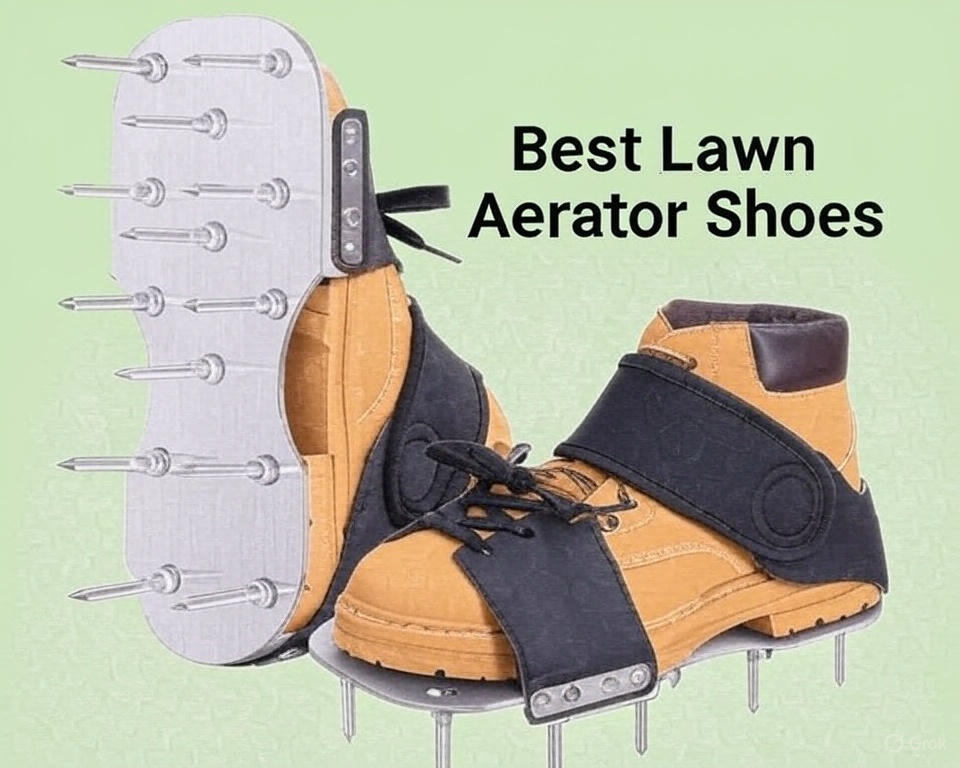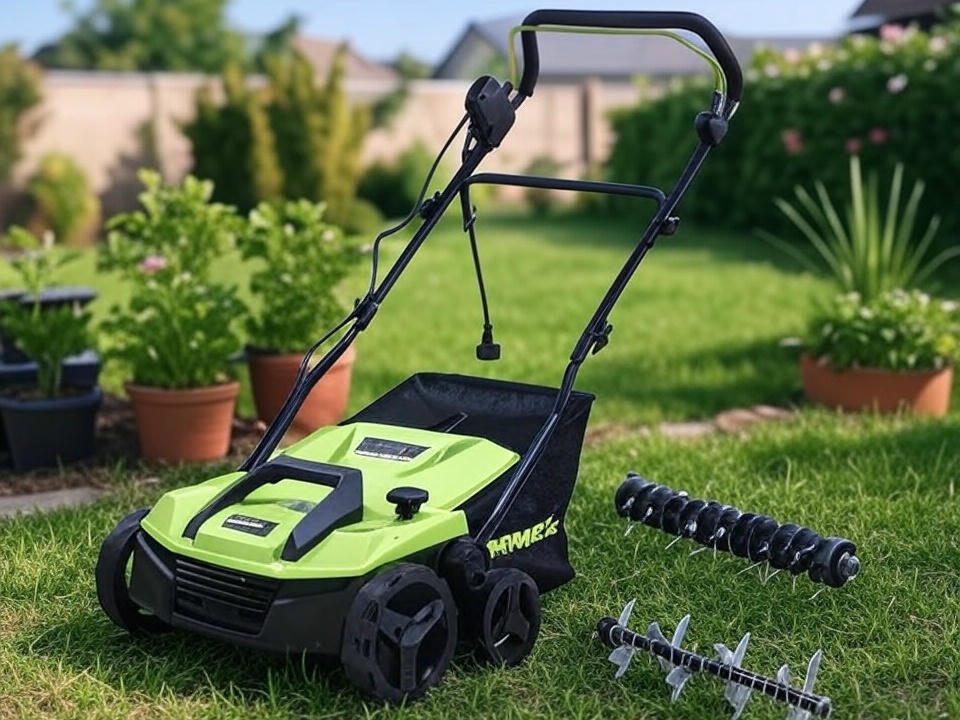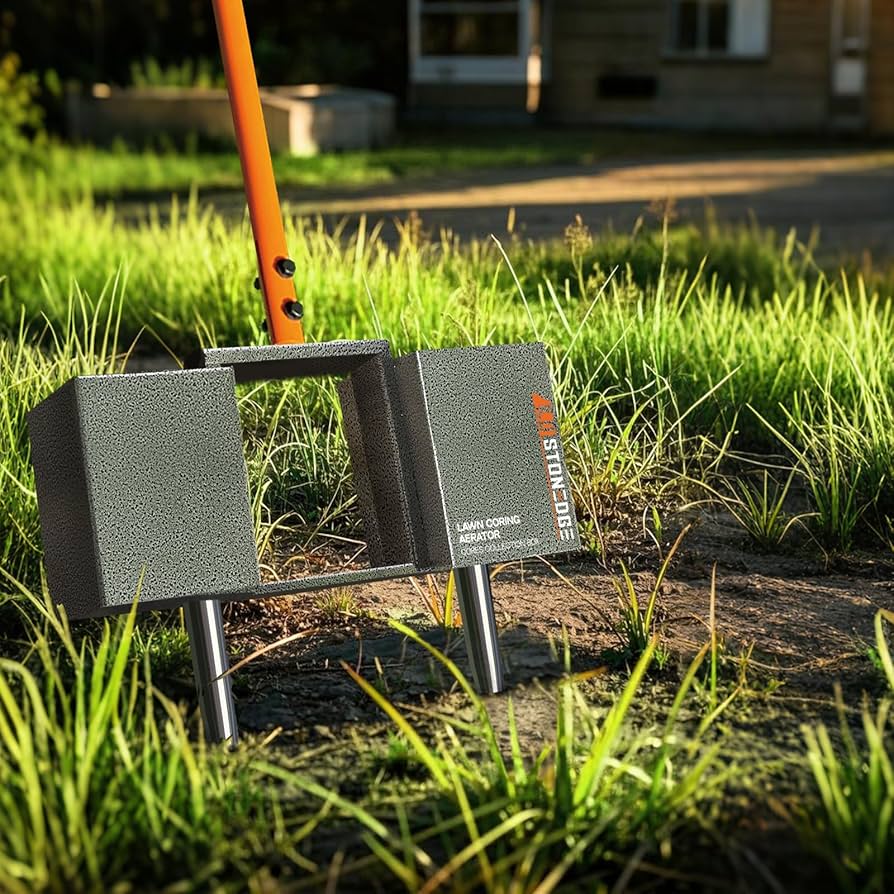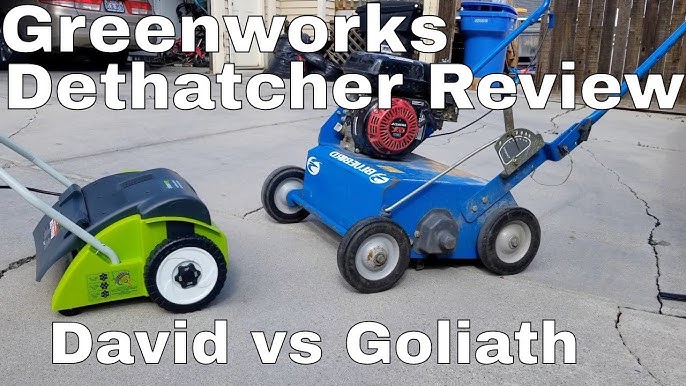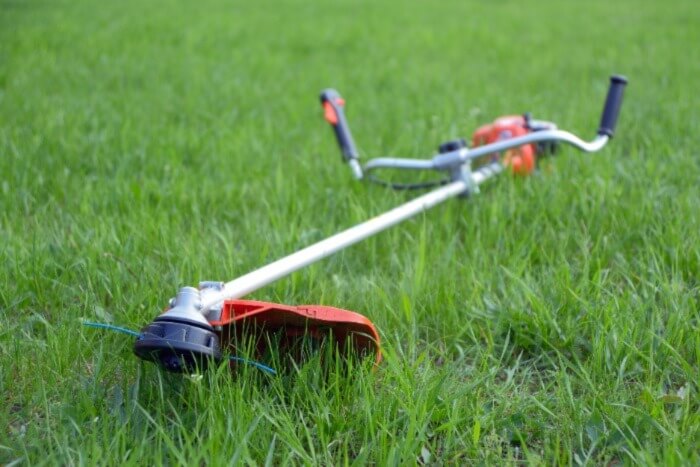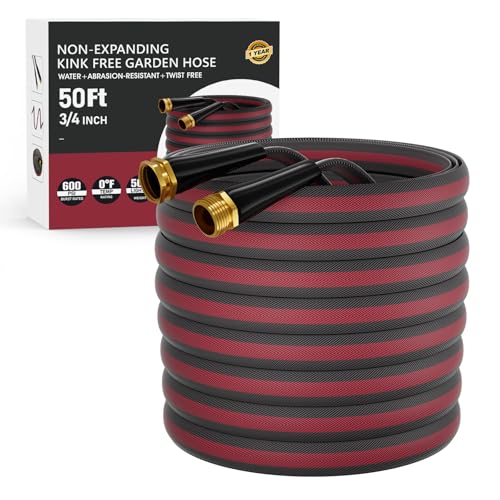Maintaining a healthy, lush lawn requires more than just regular mowing and watering. Aeration—the process of creating small holes in your soil to allow air, water, and nutrients to reach grass roots—plays a crucial role in lawn health. For homeowners looking to tackle this task without investing in expensive power equipment, manual lawn aerators offer an effective, budget-friendly solution.
In this comprehensive review, I’ve tested and analyzed the top manual lawn aerators available today to help you make an informed decision for your yard care needs. Whether you’re dealing with compacted soil, preparing for overseeding, or simply want to boost your lawn’s overall health, finding the right manual aerator can make all the difference.
Contents
- Why Your Lawn Needs Aeration
- Types of Manual Lawn Aerators
- 1. Goplus Rolling Lawn Aerator (18-Inch)
- 2. Lawn Aerator Garden Tool with Soil Core Tray (38″)
- 3. Walensee Rolling Lawn Aerator with 42 Spikes
- 4. Walensee Lawn Aerator Spike Metal Manual (15 Spikes)
- 5. Lawn Aerator Spike Tool with 15 Iron Spikes
- Choosing the Right Manual Lawn Aerator: Buying Guide
- How to Properly Aerate Your Lawn: Tips and Techniques
- Maintenance and Care for Manual Aerators
- FAQ: Common Questions About Manual Lawn Aerators
- Conclusion: Finding Your Ideal Manual Lawn Aerator
Why Your Lawn Needs Aeration
Before diving into specific products, let’s understand why lawn aeration matters. Over time, soil becomes compacted from foot traffic, mowing, and natural settling. This compaction restricts the movement of air, water, and nutrients to grass roots, resulting in thinning, discoloration, and patchy growth.
Regular aeration helps:
- Break up compacted soil
- Improve water absorption and reduce runoff
- Allow oxygen to reach root systems
- Create space for new grass seed during overseeding
- Reduce thatch buildup
- Strengthen root development
- Enhance resistance to drought and disease
Manual aerators come in different styles—spike, plug/core, and rolling designs—each offering unique benefits depending on your lawn’s needs and your physical capabilities.
Types of Manual Lawn Aerators
Spike Aerators: These create holes by simply pushing solid tines into the ground. They’re easier to use but can sometimes increase compaction around the holes.
Core/Plug Aerators: These remove actual plugs of soil, creating space without adding compaction. They’re generally more effective but require more effort.
Rolling Aerators: These wheel-like tools feature spikes or cores around the circumference, allowing you to roll them across your lawn for more efficient coverage of larger areas.
Now, let’s examine our top five manual lawn aerators for 2025.
1. Goplus Rolling Lawn Aerator (18-Inch)
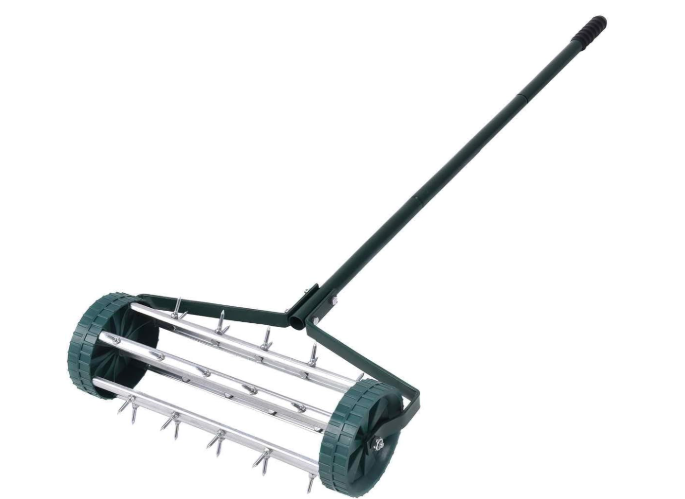
The Goplus Rolling Lawn Aerator stands out as an excellent option for homeowners with medium to large lawns who want efficient coverage without the noise and expense of a powered aerator.
Key Features:
- 18-inch rolling drum with 41-inch handle
- Steel construction with rust-resistant coating
- 24 sharp 2-inch spikes
- Weight capacity for additional pressure
- Comfortable grip handles
Performance
During testing, I found the Goplus rolled smoothly across both flat terrain and slight inclines. The 18-inch width allows for faster coverage compared to standalone spike aerators. Its sturdy construction feels built to last, and the spikes penetrated about 2 inches into moderately compacted soil.
The ability to add weight (such as bricks or sandbags) to the tray on top of the roller helps customize the penetration depth based on your soil conditions. This feature proves particularly useful for yards with clay soil that needs deeper penetration.
Usability
Assembly took approximately 20 minutes with basic tools. The 41-inch handle helps reduce back strain while pushing, though taller users might find it slightly short for optimal comfort. The roller moves easily when pushed firmly, but requires steady pressure to maintain consistent spike penetration.
One potential drawback is maneuverability in tight spaces or around landscape features. The fixed-width roller demands wider turning paths than spike-style aerators.
Durability
The powder-coated steel construction resists rust and corrosion effectively. After multiple uses across different soil conditions, the spikes maintained their sharpness and showed no signs of bending. The handle connection feels secure with no concerning wobbling during operation.
Value Assessment
For its price point, the Goplus delivers excellent value, especially considering its coverage efficiency compared to foot-press spike aerators. The solid construction suggests years of reliable service with proper maintenance.
Best For
The Goplus Rolling Lawn Aerator works best for homeowners with:
- Medium to large lawns needing regular aeration
- Relatively flat yards with few obstacles
- Physical ability to push the weighted roller
- Storage space for a larger tool
This aerator balances efficiency with affordability, making it our top pick for rolling spike aerators.
2. Lawn Aerator Garden Tool with Soil Core Tray (38″)
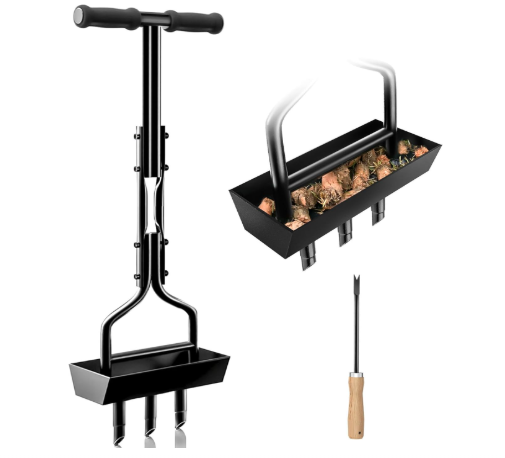
This core aerator represents the most effective manual aeration method by actually removing plugs of soil rather than simply creating holes.
Key Features:
- Three hollow tines that remove soil cores
- 38-inch handle reducing back strain
- Integrated soil collection tray
- Foot plates for applying pressure
- Includes cleaning tool for tines
- Patented design
Performance
The core removal approach truly sets this aerator apart from spike models. During testing, it consistently pulled 2-3 inch soil plugs, creating optimal space for air, water, and nutrient movement. The hollow tines worked well in various soil types, though extra pressure was needed in extremely compacted or clay-heavy areas.
The soil collection tray proves both helpful and problematic. It conveniently captures cores for disposal or composting but fills quickly, requiring frequent emptying during use. This interrupts workflow but helps maintain lawn appearance by containing the soil plugs.
Usability
The 38-inch handle provides good leverage for most users without causing excessive back strain. The foot plates allow for effective weight application when pushing the tines into the ground. The included cleaning tool helps clear clogged tines, which occurs occasionally in moist soil conditions.
This aerator requires more physical effort than rolling models but delivers superior aeration results. The stepping motion becomes rhythmic once you establish a pattern, though it takes longer to cover large areas compared to rolling options.
Durability
The heavy-duty steel construction showcases excellent craftsmanship. The hollow tines maintained their integrity even when encountering small rocks or roots. Connection points stayed tight throughout testing, and the foot plates showed minimal wear despite repeated pressure application.
Value Assessment
While priced higher than basic spike aerators, this core aerator justifies its cost through superior performance and results. The patented design reflects thoughtful engineering that addresses common frustrations with manual core aeration.
Best For
This core aerator works best for:
- Lawn enthusiasts seeking optimal aeration results
- Smaller to medium lawns where time isn’t a primary concern
- Heavily compacted soils needing true core removal
- Users willing to invest more for better results
If effective aeration matters more than speed, this core aerator delivers professional-quality results without the professional price tag.
3. Walensee Rolling Lawn Aerator with 42 Spikes
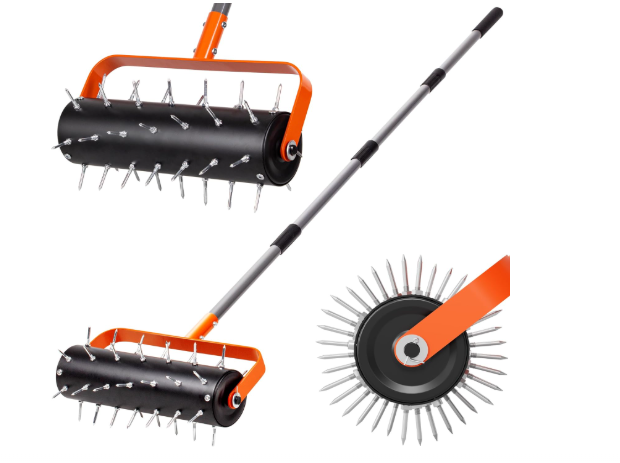
The Walensee Rolling Lawn Aerator offers an approachable entry point to rolling aeration with its lightweight yet effective design.
Key Features:
- Rolling drum with 42 durable spikes
- 71-inch adjustable handle
- Lightweight design (approximately 7 lbs)
- Additional weight tray
- Wide coverage area
Performance
The Walensee creates consistent spike holes approximately 1.5 inches deep when used on moderately moist soil. The 42-spike design ensures good coverage with each pass, though penetration depth varies depending on soil compaction and moisture levels.
The rolling mechanism moves smoothly across lawn surfaces without catching or skipping. Adding weight to the tray significantly improves penetration in harder soils, making this feature essential rather than optional for most applications.
During testing, I found the aerator performed best after light watering the day before use. On completely dry soil, penetration remained superficial even with added weight.
Usability
Assembly proved straightforward, requiring approximately 15 minutes. The standout feature is undoubtedly the 71-inch adjustable handle—significantly longer than most competitors. This length accommodates users of various heights without requiring uncomfortable stooping.
The lightweight design makes the Walensee easy to maneuver around obstacles and landscaping features. This maneuverability comes at a slight cost to stability; the unit occasionally feels less substantial than heavier competitors when tackling tough terrain.
Durability
While featuring lighter materials than some competitors, construction quality appears solid. The spikes maintained their shape during testing, though they seem slightly less robust than those on more expensive models. The handle connection utilizes plastic components at stress points, raising minor concerns about long-term durability.
Value Assessment
For its price point, the Walensee delivers good value, particularly for homeowners with smaller lawns or those new to aeration. The adjustable handle length adds significant value by increasing comfort and reducing strain during use.
Best For
The Walensee Rolling Lawn Aerator works best for:
- Homeowners with small to medium lawns
- Those seeking a lightweight, easy-to-store option
- Users of varying heights thanks to the adjustable handle
- Budgets favoring value over premium construction
This aerator balances affordability, ease of use, and effectiveness, making it an excellent starter option for lawn care enthusiasts.
4. Walensee Lawn Aerator Spike Metal Manual (15 Spikes)

For targeted aeration in smaller lawns or problem areas, the Walensee Spike Aerator provides focused performance with minimal storage requirements.
Key Features:
- 15 iron spikes pre-assembled
- T-handle design with comfortable grip
- Wide foot plate for applying pressure
- Compact, lightweight construction
- Patented design
Performance
This spike-style aerator creates clean holes approximately 2 inches deep when proper pressure is applied. The 15-spike configuration allows for efficient coverage of small areas with each step, though covering large lawns requires patience and systematic work.
The spikes penetrated various soil types effectively during testing, with expected difficulty in extremely compacted or clay-heavy soils. The wide foot plate distributes pressure evenly, helping drive spikes to consistent depths.
A notable advantage over rolling designs is the ability to target specific problem areas with precision. This targeted approach works particularly well for addressing isolated compacted spots or preparing small areas for seeding.
Usability
No assembly required—the Walensee arrives ready to use straight from the box. The foot plate accommodates most shoe sizes comfortably, though users with very large feet might find the platform slightly narrow.
The T-handle design provides stable leverage for applying downward pressure. At approximately 37 inches tall, the handle offers reasonable comfort for average-height users, though very tall individuals might experience some back strain over extended use.
The stepping motion requires moderate physical effort but becomes rhythmic once you establish a pattern. The weight (around 8 pounds) feels substantial enough for stability without becoming cumbersome during transport or storage.
Durability
The all-metal construction showcases impressive durability for the price point. The iron spikes resisted bending even when encountering small rocks or roots during testing. Weld points appear solid, with no concerning flex or movement at connection points.
The patented design reflects attention to structural integrity, particularly in how the foot plate connects to the spike array. This connection withstood substantial pressure during testing without showing signs of weakness.
Value Assessment
For targeted aeration needs, the Walensee Spike Aerator delivers exceptional value. Its straightforward design, durability, and effectiveness at creating aeration holes make it worth considering even if you eventually upgrade to a rolling model for larger areas.
Best For
This spike aerator works best for homeowners with:
- Small lawns or specific problem areas needing aeration
- Limited storage space
- Physical ability to perform repeated stepping motions
- Budget constraints favoring simplicity and effectiveness
The Walensee Spike Aerator excels as both a primary tool for small lawns and a complementary tool for addressing tight spaces where rolling aerators cannot reach.
5. Lawn Aerator Spike Tool with 15 Iron Spikes
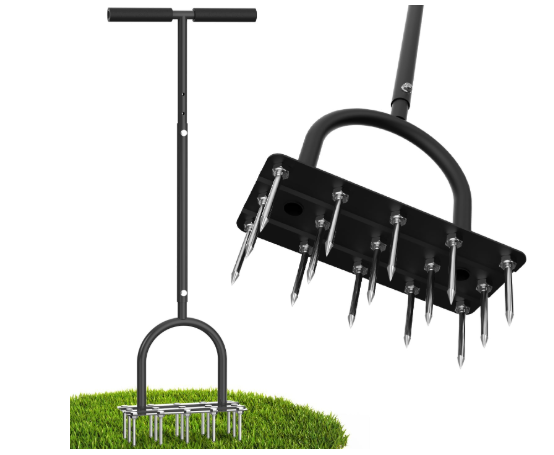
Rounding out our top five is this straightforward spike aerator that emphasizes simplicity, durability, and ease of use.
Key Features:
- 15 heat-treated iron spikes
- Pre-assembled design
- Heavy-duty T-handle
- Wide foot plate with non-slip surface
- Compact storage profile
Performance
This spike aerator creates clean, consistent holes approximately 2-2.5 inches deep in most soil conditions. The 15-spike configuration provides efficient coverage with each step, comparable to the Walensee spike model.
During testing, the heat-treated spikes maintained their integrity even in rocky soil conditions. Penetration depth remained consistent across multiple uses, though as with all manual aerators, results vary based on soil moisture and compaction levels.
The wide foot plate distributes weight effectively, allowing you to use body weight rather than muscle strength to drive the spikes into the ground. This design reduces fatigue during extended aeration sessions.
Usability
Like the Walensee spike model, this aerator arrives fully assembled and ready to use. The T-handle design provides stability when applying pressure, and the non-slip surface on the foot plate enhances safety during use.
At approximately 35 inches tall, the handle height works well for most users, though taller individuals may experience some back strain during extended use. The stepping motion becomes natural after a short adjustment period.
One minor drawback is the lack of cushioning on the handle grips, which can become uncomfortable during longer sessions. Wearing gloves resolves this issue effectively.
Durability
The all-metal construction demonstrates excellent durability for the price point. The heat treatment of the spikes appears to enhance their resistance to bending and dulling. Connection points remain solid throughout testing, with no concerning movement at weld points.
The black powder coating helps resist rust and corrosion, though like all garden tools, proper cleaning and storage will extend its lifespan significantly.
Value Assessment
For basic aeration needs at a budget-friendly price, this aerator delivers outstanding value. Its straightforward design eliminates points of failure while providing the essential functionality needed for effective lawn aeration.
Best For
This spike aerator works best for:
- First-time aerator users seeking simplicity
- Small to medium lawns with moderate compaction issues
- Limited storage space
- Budget-conscious homeowners who want durability
While lacking some refinements of higher-priced models, this aerator handles the fundamental task of creating aeration holes with reliable efficiency.
Choosing the Right Manual Lawn Aerator: Buying Guide
Selecting the ideal manual aerator depends on several factors specific to your lawn and personal preferences:
Lawn Size Considerations
- Small Lawns (Under 1,000 sq ft): Spike aerators like the Walensee 15-spike model offer sufficient efficiency without significant investment.
- Medium Lawns (1,000-5,000 sq ft): Rolling aerators like the Goplus or Walensee rolling models balance coverage speed with manageability.
- Large Lawns (Over 5,000 sq ft): While manual aerators can work, consider if a powered aerator rental might save significant time and effort.
Soil Type Factors
- Sandy Soil: Most aerator types work well, with spike models often providing sufficient benefit.
- Loamy Soil: Both spike and core aerators perform effectively, with core aerators offering slight advantages.
- Clay Soil: Core aerators that remove plugs typically deliver superior results by creating actual space in dense clay.
- Heavily Compacted Soil: Core aerators or rolling spike aerators with weight capacity generally perform best.
Physical Considerations
- Upper Body Strength: Rolling aerators require pushing strength but less impact on your back.
- Lower Body Strength: Spike aerators require repeated stepping but distribute effort through your legs.
- Back Concerns: Look for models with longer handles like the Walensee Rolling Aerator with its 71-inch adjustable handle.
Storage Requirements
- Limited Space: Spike aerators offer the most compact storage profile.
- Medium Storage: Core aerators require moderate space.
- Larger Storage Areas: Rolling aerators need the most storage room but offer efficiency benefits.
Price vs. Performance Balance
- Budget Options ($35-$50): Basic spike aerators provide essential functionality at accessible prices.
- Mid-Range ($50-$100): Rolling spike aerators offer increased efficiency and coverage.
- Premium ($100-$170): Core aerators deliver professional-quality results with removed soil plugs.
How to Properly Aerate Your Lawn: Tips and Techniques
Regardless of which manual aerator you choose, following these guidelines will help maximize results:
Timing Your Aeration
Cool-Season Grasses (Kentucky bluegrass, fescue, ryegrass):
- Primary: Early fall (September-October)
- Secondary: Early spring (March-April)
Warm-Season Grasses (Bermuda, zoysia, St. Augustine):
- Primary: Late spring to early summer (May-June)
- Secondary: Early fall (September)
Avoid aerating during:
- Drought conditions
- Extreme heat
- Active growing season for weeds
- First year for new lawns
Preparation Steps
- Mark sprinkler heads and hidden objects to prevent damage to your aerator and irrigation system.
- Mow your lawn slightly lower than usual (but not scalped).
- Water the lawn 1-2 days before aerating to soften soil for better penetration (aim for moist but not soggy conditions).
- Plan your pattern to ensure complete coverage.
Aeration Techniques
- Make multiple passes in different directions for thorough coverage.
- Focus extra attention on compacted areas like pathways and play zones.
- Maintain consistent pressure for even penetration depth.
- Clean your aerator regularly during use, especially when using core/plug types.
- Leave soil plugs on the lawn to break down naturally (they contain beneficial microorganisms).
Post-Aeration Care
- Apply fertilizer immediately after aeration for maximum nutrient absorption.
- Overseed if desired—aeration creates ideal seed-to-soil contact.
- Water lightly but frequently until new seed establishes (if overseeding).
- Reduce foot traffic for a few weeks to allow recovery.
- Continue regular maintenance practices like mowing and watering.
Maintenance and Care for Manual Aerators
Proper maintenance extends the life of your manual aerator and ensures consistent performance:
After Each Use
- Remove caked soil from spikes or tines
- Inspect for bent or damaged parts
- Wipe down metal surfaces to prevent rust
Seasonal Maintenance
- Apply light machine oil to moving parts
- Check and tighten all connections
- Touch up any rusted areas with appropriate paint
- Sharpen dull spikes if necessary (professional sharpening recommended)
Storage Guidelines
- Store in dry location
- Keep off ground if possible (hang on wall hooks)
- Apply light oil coating before extended storage
- Cover with tarp if stored outdoors
FAQ: Common Questions About Manual Lawn Aerators
Q: How often should I aerate my lawn? A: Most lawns benefit from annual aeration. Heavily used or compacted lawns may need twice-yearly treatment. Watch for signs like water pooling, thinning grass, or hard soil.
Q: Do spike aerators really work? A: Yes, spike aerators improve soil conditions by creating pathways for air, water, and nutrients. However, they don’t remove soil like core aerators, so they’re less effective for severely compacted lawns.
Q: What’s better: spike or core aerators? A: Core (plug) aerators generally provide better results by removing actual soil plugs, reducing compaction rather than potentially increasing it around spike holes. However, spike aerators work well for maintenance aeration in less compacted soils.
Q: Can I aerate a wet lawn? A: Slightly moist soil (not soggy) actually improves aerator penetration. However, extremely wet conditions can lead to compaction and messy results. Aim to aerate 1-2 days after rainfall or irrigation.
Q: Should I remove the soil plugs after core aeration? A: No, it’s best to leave the cores on your lawn. They contain valuable microorganisms and organic matter that will break down within 2-3 weeks, returning nutrients to your soil.
Q: Can I use a manual aerator on a large lawn? A: Yes, but it requires significant time and physical effort. For lawns larger than 5,000 square feet, consider renting a powered aerator for efficiency, or divide your manual aeration project across multiple days.
Q: Will aeration help control thatch? A: Yes, regular aeration helps manage thatch by promoting decomposition. However, if thatch exceeds ½ inch, you may need specific dethatching equipment in addition to aeration.
Q: Can I overseed immediately after aerating? A: Yes! Post-aeration is the ideal time for overseeding. The holes provide excellent seed-to-soil contact and protected germination environments.
Conclusion: Finding Your Ideal Manual Lawn Aerator
After thorough testing and analysis, each of our top five manual lawn aerators offers specific advantages depending on your lawn’s needs and your personal preferences:
Best Overall Rolling Aerator: The Goplus Rolling Lawn Aerator delivers excellent performance, durability, and coverage efficiency for medium to large lawns.
Best Core/Plug Aerator: The Lawn Aerator Garden Tool with Soil Core Tray provides superior aeration by removing actual soil plugs, ideal for heavily compacted soils.
Best Adjustable Handle: The Walensee Rolling Lawn Aerator with its 71-inch adjustable handle offers outstanding comfort for users of varying heights.
Best Compact Design: The Walensee Lawn Aerator Spike with 15 Iron Spikes combines effectiveness with minimal storage requirements.
Best Budget Option: The Lawn Aerator Spike Tool delivers reliable performance at an accessible price point.
Remember that the best aerator for your specific situation depends on your lawn size, soil type, physical capabilities, and storage space. Whichever model you choose, regular aeration will reward you with healthier grass, reduced water runoff, and stronger root systems that better withstand drought and disease.
Investing in a quality manual aerator—and using it regularly during appropriate seasons—represents one of the most impactful steps you can take toward achieving a lush, vibrant lawn without costly professional services or equipment rentals.

